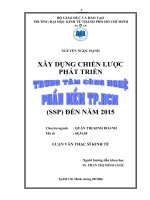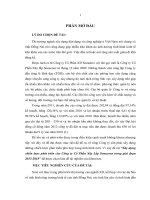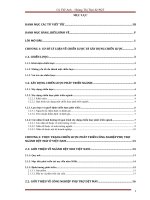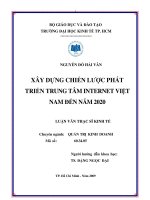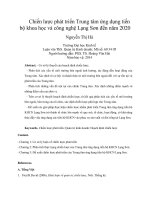Chiến lược phát triển trung tâm ngoại ngữ, học viện tài chính (AOF) giai đoạn 2013 2017
Bạn đang xem bản rút gọn của tài liệu. Xem và tải ngay bản đầy đủ của tài liệu tại đây (767.94 KB, 140 trang )
THAI NGUYEN UNIVERSITY
Socialist Republic of Vietnam
SOUTHERN LUZON STATE
UNIVERSITY
Republic of the Philippines
STRATEGIC PLAN OF THE ACADEMY OF FINANCE (AOF) CENTER
FOR FOREIGN LANGUAGES, HANOI, VIET NAM FOR THE YEARS
2013-2017
A RESEARCH PROPOSAL PRESENTED TO THE FACULTY OF GRADUATE
SCHOOL SOUTHERN LUZON STATE UNIVERSITY LUCBAN, QUEZON,
PHILIPPINESTHAI NGUYEN UNIVERSITY S.R. VIETNAM
IN PARTIAL FULFILLMENT OF THE REQUIREMENTS FOR THE DEGREE
DOCTORS IN BUSINESS ADMINISTRATION
Name: Nguyen ThiThuyTrang
Thai Nguyen, 2013
1
ACKNOWLEDGMENT
I would like to express my most sincere thanks to the Management Board of the
Southern Luzon State University, Thai Nguyen University, teachers of the school have
helped me facilitate the learning process throughout.
I would like to express sincere gratitude and profound Dr.Walberto A.
Macaraan, enthusiastic teacher who has dedicated guidance, encouragement,
spending time and exchange orientation for me during this research.
I sincerely thank the Board of Academy of Finance (AOF), colleagues in AOF,
classmates DBA1, especially Mr. Ngo Anh Cuong, facilitated enthusiastic help and
share experience to help complete the thesis.
Finally, I would like to thank my best friends who have encouraged me to
complete my thesis.
2
Contents
STRATEGIC PLAN OF THE ACADEMY OF FINANCE (AOF) CENTER FOR
FOREIGN LANGUAGES, HANOI, VIET NAM FOR THE YEARS 2013-2017.............1
IN PARTIAL FULFILLMENT OF THE REQUIREMENTS FOR THE DEGREE
DOCTORS IN BUSINESS ADMINISTRATION ................................................................1
ACKNOWLEDGMENT............................................................................................................2
ABSTRACT...............................................................................................................................5
List of tables...............................................................................................................................7
CHAPTER I: INTRODUCTION...............................................................................................8
1.1 Background of the study ................................................................................................11
1.2 Statement of the problem ...............................................................................................12
1.3 Significance of the study................................................................................................15
1.4 Scope and limitation of the study: .................................................................................15
1.5 Terms: ............................................................................................................................16
CHAPTER II: REVIEW OF RELATED LITERATURE AND STUDIES............................19
2.1 Requirement of English proficiency ..............................................................................19
2.2 Establishment of a language center in a business educational institution .....................19
2.3 General environment in Vietnam...................................................................................21
2.3.1 Natural environment ...............................................................................................21
2.3.2 Historical and political situation .............................................................................21
2.3.3 Socio-cultural factors ..............................................................................................22
2.3.4 Economic profile.....................................................................................................24
2.4 Education Industry .........................................................................................................28
2.4.1 General Education System in Vietnam ...................................................................28
2.4.2 Viewpoint on education development ....................................................................30
2.4.3 Demand and Supply Analysis.................................................................................31
2.4.4 Competitor Analysis ...............................................................................................36
2.4.5 Introduction of Best Practices.................................................................................48
2.5 Opportunities and Threats..............................................................................................51
CHAPTER III: METHODOLOGY .........................................................................................56
3.1 Research design .............................................................................................................56
3.2 Determination of sample size.........................................................................................58
3.3 Sampling design and techniques....................................................................................59
3.4 Research instrument.......................................................................................................61
3.5 Data gathering procedure...............................................................................................61
3.6 Data processing method.................................................................................................61
Chapter IV: Company study, data analysis and findings.........................................................63
3
4.1 Brief history of AOF and CFL.......................................................................................63
4.2 Overall performance ......................................................................................................63
4.3 Institutional Activities....................................................................................................64
4.3.1 Major activities ...........................................................................................................64
4.3.1.1 Logistics...............................................................................................................64
4.3.1.2 Operations ............................................................................................................74
4.3.1.3 Marketing and sales .............................................................................................78
4.3.2 Support activities ........................................................................................................86
Chapter V: Strategic Plan – Conclusions and Recommendations ...........................................96
5.1 CFL’s Vision, Mission, Objectives and Key Result Areas............................................96
5.2
Current strategy .......................................................................................................100
5.2.1 Organizational Strategy ........................................................................................100
5.2.2 HRM strategy........................................................................................................100
5.2.3 Operating strategy.................................................................................................101
5.2.4 Marketing strategy ................................................................................................102
5.2.5 Financial strategy ..................................................................................................102
5.3 Recommended strategic plan .......................................................................................102
5.4 Comparison with the current strategy ..........................................................................104
5.5 Management of changes ..............................................................................................105
5.5.1 Organizational Strategy ........................................................................................106
5.5.2 HRM Strategy .......................................................................................................106
5.5.3 Operations Strategy...............................................................................................112
5.5.4 Financial Strategy .................................................................................................116
APPENDICIES ......................................................................................................................118
REFERENCES: .....................................................................................................................134
BIBLIOGRAPHY..................................................................................................................137
4
ABSTRACT
Academy of Finance is one of very few nationally recognized State-owned
universities in Vietnam and has provided the economy with highly appreciated graduates in
banking, finance and accounting. However, in recent years, with higher requirement of
English proficiency from employers, Academy of Finance graduates have faced competition
from other universities’ graduates whose majors of banking, finance or accounting are said to
be less appreciated. The tendency of English proficiency requirement can be seen in many
job advertisements found in various job sites such as Vietnamworks.com, vieclam.com,
dulieuvieclam.com, timviecnhanh.com,… According to Ministry of Education and Training,
students can graduate from university only when they reach a certain proficiency of English.
Also, the ministry requires each university to set its own requirement of English proficiency.
Accordingly, Academy of Finance requires 450 TOEIC for graduation. This is compulsory
for the 48th batch and batches later.
To better meet job requirements and able to graduate, undergraduates plan to get
prepared with English during their university. They are free to choose an English center as
long as they can obtain some certain certificates such as IELTS, TOEFL, TOEIC. Some
universities provide their undergraduates with another choice of their own language centers
and learners are free to choose to sit in an exam for an international certificate or certificates
issued by universities. Academy of Finance could not increase the in-class time of English
lessons, so out-of-school time programs were recommended. In fact, Academy of Finance set
up its own language center in 2010 to serve firstly its own students and then other interests.
It is a kind of out of school time program for students.
CFL was established by the Director of Academy of Finance in 2010 with the aim of
providing AOF students with English proficiency to better meet the market’s needs. CFL
focuses on English while other OST programs are topic-specific and focus on categories like
the arts, sports, theatre, math or science. CFL is a not for profit organization under the direct
5
control of Academy of Finance. It is different from other commercial language centers in the
market and also differs from other college’s/university’s centers that are directly controlled
by Faculty of Foreign Languages of the college/university.
6
List of tables
Table
1
2
3
4
Pages
Population growth rate in 1990 – 2010
Gross domestic product at constant 1994 prices by economic sector
Gross domestic product at current prices by economic sector
Enterprises in Vietnam are classified by capital sources and ownership
15
16
17
18
Retail sales of goods and services at current prices by kind of economic
5
activity
18
Structure of employed population at 15 years of age and above as of annual 1
6
July by kinds of economic activity
20
7
CHAPTER I: INTRODUCTION
Today Vietnam has involved in the global integration both vertically and horizontally. This
has led to the requirement of English proficiency from employers toward job seekers. In this
context, Vietnam’s public schools are serving their students under increasing pressure to
improve academic performance. The inexorable drive to reach continuously higher levels of
student achievement was spurred by the Ministry of Education and Training – MOET’s
requirements in English proficiency. The current economic recession has only exacerbated
the stress on educators at all levels, as they are expected to push students’ achievement scores
higher than ever before (while also closing achievement gaps between different sub-groups of
students), despite diminishing resources that have resulted in staffing cuts, larger class sizes,
and fewer support services for many of the nation’s students.
The increased emphasis on student achievement in general and student’s English proficiency,
as measured by large-scale, state-mandated summative assessments, has resulted in school
leaders and education policymakers embracing the notion that teachers can no longer afford
to work in isolation if they seek to improve the performance of their students. This trend is
apparent in the current literature on professional development, where one can find an
abundance of articles and books extolling the virtues of teacher learning teams, collaborative
learning teams, communities of continuous inquiry, professional learning communities, and
other configurations of collaborative work arrangements among teachers. In reality,
educational researchers and advocates for educational reform have been writing about various
forms of teacher collaboration as a means to improve educational outcomes since the early
1990’s (Hord, 2004; Pounder, 1998). As Saunders, Goldenberg, and Gallimore (2009)
indicated, there is “an intuitively appealing logic that underlies PLC [professional learning
communities] and learning team programs” (p. 1009). Yet, despite the significant body of
literature regarding the importance of teacher collaboration in the effort to improve schools
and the “intuitive logic” of such an approach, there is a dearth of empirical research that ties
8
collaborative processes to improved teacher practice and improved student learning
(Gallimore, Ermeling, Saunders, & Goldenberg, 2009; Goddard, Goddard, &TschannenMoran, 2007; InPraxis Group, Inc., 2006; Pounder, 1998; Saunders et al., 2009; Vescio, Ross,
& Adams, 2008). The following quote from InPraxis Group, Inc. (2006) captures the current
body of literature and contemporary wisdom regarding the value of teacher collaboration and
PLC-like approaches:
Although there is little empirical research that links collaborative processes directly
with
student
learning
and
achievement,
there
is
a
relatively
consistent
recommendation emerging from the literature on professional development – those
who share the same concerns and challenges will learn more effectively if they work
together in a professional development experience and teacher quality can be
positively affected. (p. 33)
The relative paucity of empirical research supporting the effectiveness of professional
learning communities (PLCs) begs the following question: In schools that have implemented
PLCs, to what extent have teacher practice and student achievement improved? This is the
key question driving the establishment of out-of-school time programs while schools have to
follow MOET’s rules of limited in-class time. Although a number of studies have
documented evidence regarding the various benefits of PLCs, for example, enhanced teacher
learning (Little, 2003; Grossman, Wineberg, & Woolworth, 2001), improved school culture
(Supovitz, 2002), and changes in classroom practice (Brownell, Adams, Sindelar, Waldron,
&Vanhover, 2006), the most valuable aspect of PLCs lies in their potential to impact student
achievement in a positive manner. As Brownell et al. (2006) argued, “Ultimately,
professional collaborative efforts are important only if they help teachers change in ways that
promote student learning” (p. 184).
9
Academy of Finance is one of very few nationally recognized State-owned universities in
Vietnam and has provided the economy with highly appreciated graduates in banking,
finance and accounting. However, in recent years, with higher requirement of English
proficiency from employers, Academy of Finance graduates have faced competition from
other universities’ graduates whose majors of banking, finance or accounting are said to be
less appreciated. The tendency of English proficiency requirement can be seen in many job
advertisements found in various job sites such as Vietnamworks.com, vieclam.com,
dulieuvieclam.com, timviecnhanh.com,… According to Ministry of Education and Training,
students can graduate from university only when they reach a certain proficiency of English.
Also, the ministry requires each university to set its own requirement of English proficiency.
Accordingly, Academy of Finance requires 450 TOEIC for graduation. This is compulsory
for the 48th batch and batches later.
To better meet job requirements and able to graduate, undergraduates plan to get prepared
with English during their university. They are free to choose an English center as long as they
can obtain some certain certificates such as IELTS, TOEFL, TOEIC. Some universities
provide their undergraduates with another choice of their own language centers and learners
are free to choose to sit in an exam for an international certificate or certificates issued by
universities. Academy of Finance could not increase the in-class time of English lessons, so
out-of-school time programs were recommended. In fact, Academy of Finance set up its own
language center in 2010 to serve firstly its own students and then other interests. It is a kind
of out of school time program for students.
Out of School Time (OST) is a general term that describes any structured programs outside of
the normal school day hours. "The National Institute on Out-of-School Time defines out-ofschool time programs as encompassing a wide range of program offerings for young people
that take place before school, after school, on weekends, and during the summer and other
10
school breaks " ("Making an Impact on Out-of-School Time: A Guide for Corporation for
National Service Programs Engaged in After-School, Summer, and Weekend Activities for
Young People," 2000, p. 3). The programs are sometimes referred to as "after-school,"
"extended day," or "school-aged care" programs and can occur before or after school or
during the vacation days. These terms are often used interchangeably.
CFL focuses on English while other OST programs are topic-specific and focus on categories
like the arts, sports, theatre, math or science.
While the definition of OST is quite broad, the OST programs reviewed for this research
study are those specifically created to meet the goals of English proficiency. The specific
program goal for CFL is, "To provide AOF students with English proficiency." CFL has
become a response to combat the factors facing newly-graduated job seekers and to meet the
academic and social needs of students.
This school year, Academy of Finance is welcoming the 50th batch to the campus. It means
only 2 years left for the 48th batch to get themselves ready for graduation and job market. As
far as I observed, Center of Foreign Languages affiliated with Academy of Finance has not
achieved any success which is shown in enrollment. As not only a teacher of English in
Academy of Finance but also the Associate Dean of Faculty of Foreign Languages who is in
charge of cooperating with Center of Foreign Languages in serving Academy of Finance
students, I personally think that a study on Center of Foreign Languages is in need to find out
a strategic plan for its development in order to implement its mission and vision.
1.1 Background of the study
CFL was established by the Director of Academy of Finance in 2010 with the aim of
providing AOF students with English proficiency to better meet the market’s needs.
However, CFL has served only few groups of about 300 students, far less than expected, out
11
of more than 10,000 present students. This is a disappointing result. Therefore, the question
of how to attract students to the center has been discussed for an answer.
CFL is a not for profit organization under the direct control of Academy of Finance. It is
different from other commercial language centers in the market and also differs from other
college’s/university’s centers that are directly controlled by Faculty of Foreign Languages of
the college/university.
Studies or researches on commercial language centers in Vietnam, especially in Hanoi have
not been fully publicized though some researches on market needs have been cited on
newspapers and magazines. The information from these researches can be used as secondary
data for this study. However, the special situation of CFL requires further research and deeper
analysis. That’s why the thesis is conducted toward the solution to CFL’s performance. It is
aimed at how to increase the performance of CFL – a provider of OST programs via a
feasible strategic plan for CFL.
1.2 Statement of the problem
The study is to aim at building a strategic plan for CFL – Center of ForeignLanguages – an
affiliation with AOF – Academy of Finance, Hanoi, Vietnam. The study is also to examine
teacher collaboration designed to influence teachers’ classroom practice and student
achievement outcomes in AOF and CFL. The study is conceptually grounded in social
capital theory (Leana&Pil, 2006; Nahapiet&Ghoshal, 1998) and the construct of strategic
plan both of which will be presented in Chapter 2. In short, social capital theory posits that
the network of interpersonal relationships which exist within any organization is a valuable
resource that has the potential to improve organizational performance (Nahapiet&Ghoshal,
1998). Social capital theory is essentially interrelated with research-based descriptions of
collaboration practice; these organization-based groups are also viewed as powerful units of
analysis with the potential to improve overall organizational performance (Koliba&Gajda,
12
2009). This study will explore the relationship between the quality of collaboration within
teacher-based teams and student achievement outcomes as measured by mandated, annual
assessments. In addition, the study will address the impact of administrative leadership on the
success of CFL by examining the relationship between teachers’ perceptions of
administrative support for discrete teacher teams (PLCs) and student achievement outcomes,
again measured by mandated, annual state assessments. Also, the study will explore the
relationship between the quality of teacher collaboration and self-reported changes in
instructional practice. Finally, the study will analyse the students’ expectations and
perception toward CFL, conduct market research for CFL and many other related issues to
come up with a feasible strategic plan for CFL. To that end, the research will address the
following:
• environmental factors affecting the industry, its macro and micro dimensions;
• general structure of the Education Industry, of higher education industry, especially
of business educational institutions;
• potential threats and opportunities, strengths and weaknesses in the industry of
business educational institutions and language centers;
• to what extent, a relationship between the quality of teacher collaboration on
discrete teacher teams and student achievement outcomes;
• to what extent, a relationship between teachers’ perceptions of administrative
support for discrete teacher teams and student achievement outcomes;
• key success factors for AOF within the industry of business educational institutions
and for CFL;
• how CFL moves forward.
The study is conducted through analysis and synthesis of data gathered from primary and
secondary sources.
13
Primary data will be from interviews and surveys. Interviews will be conducted with the key
officials, employees of AOF and CFL, its competitors and its employees. Internal and
external surveys will be conducted to determine the level of awareness, perception toward
and image of CFL; the satisfaction level of learners and employees of the center.
The primary data will be collected by the author through offline surveys, interviews with
CFL stakeholders. The questions the author asks are tailored to elicit the data that will help
him/her with the study.
Secondary sources will be collected from the AOF reports, published materials of Ministry of
Finance, Ministry of Education and Training. This study also refers to the Government
policies, official magazines on the topics relevant to the MRR from various institutions and
universities in Vietnam.
There are several types of secondary data. They can include information from the Center,
AOF, Ministry of Education and Training, some employers, jobsites or other government
statistical information. Secondary data tends to be readily available and inexpensive to obtain.
In addition, secondary data can be examined over a longer period of time. With a
combination of these two data sources, the researcher are able to determine which factors are
critical to the Center’s performance. Both primary data and secondary data have their pros
and cons. Primary data offers tailored information but tends to be expensive to conduct and
takes a long time to process. Secondary data is usually inexpensive to obtain and can be
analyzed in less time. However, because it was gathered for other purposes, the researcher
may need to tease out the information to find what he/she is looking for. Due to the limited
budget, skills and available resources, the researcher chose to use both primary data and
secondary data.
14
1.3 Significance of the study
The study is very important for the existence of CFL as well as the reputation of AOF. 10
years ago, AOF’s teachers of English were all not majored in English but Russian. Over the
last 10 years, only English-majoring applicants have been recruited as teachers of English at
AOF. However, it is still a common knowledge that AOF graduates with low proficiency of
English are mainly due to non-English majoring teachers of English at AOF. It is also
believed to be the reason for not many AOF students to come to enroll in CFL.
The study of Strategic Plan for CFL would bring benefits to AOF when CFL’s success would
change the society’s perception on AOF’s students and teachers of English. Faculty of
Foreign Languages also gets benefited from CFL’s success in this sense. Each individual
teacher would get more offers from external markets. After all, AOF graduates would be the
first and most important beneficiary because they have a good in-campus center for their
English learning. Personally, I find myself benefited too because as a leader, I need to bring
good changes to my students and my teachers.
1.4 Scope and limitation of the study:
The study mainly focuses on CFL’s current situation, target market and successful examples
in the sector. Besides, it is also about feasibility of some options to come up with a
recommendation for CFL.
The study looks at AOF since 2000 to present and CFL from its establishment in August
2010 to present.
The study is done through interviews and surveys.
The results of the study can be affected by a small number of stakeholders in interviews and
surveys.
15
1.5 Definition of terms:
English proficiency - is the ability of an individual to speak or perform in an acquired
language, English. As theories among pedagogues as to what constitutes proficiency go, there
is little consistency as to how different organizations classify it.
Additionally, fluency and language competence are generally recognized as being related, but
separate controversial subjects. In predominant frameworks in the United States, proficient
speakers demonstrate both accuracy and fluency, and use a variety of discourse
strategies. Thus, native speakers of a language can be fluent without being considered
proficient. This is also true for non-native English speakers who are expected to be fluent and
accurate at the same time.
Teacher collaboration – is the act of collaborating between teachers before, during and after
their lessons. It can be as simple as teachers’ working together to make connections across
curriculum or as true collaborative as their checking calendars for their next week meeting
scheduling. Together, they would begin to construct fully structured bridges between their
curriculums that would not only bring them deep professional satisfaction, more importantly;
they would enrich the learning experiences of their students.
Teacher image – is the general opinion of most learners about a certain teacher. Teacher
image can include his/ her knowledge, qualifications, teaching style, interpersonal skills,
pronunciation, handwriting or even his/ her dressing.
Academic curriculum – or the academic program of study is the degree that the student is
working toward achieving, also referred to as "sought learner outcome" (sought degree).
Curriculum rules in the system control the academic requirements defined in the approved
program of study (i.e., the student curriculum), represented by the program code in Banner.
Curriculum rules are also used in conjunction with program codes to populate major, minor,
concentrating, department, or other related discrete pieces of data, to a variety of student
record tables (e.g., student level).
16
Teaching methodology – has been characterized in a variety of ways. A more or less
classical formulation suggests that methodology is that which links theory and practice.
Theory statements would include theories of what language is and how language is learned
or, more specifically, theories of second language acquisition (SLA). Such theories are linked
to various design features of language instruction. These design features might include stated
objectives, syllabus specifications, types of activities, roles of teachers, learners, materials,
and so forth. Design features in turn are linked to actual teaching and learning practices as
observed in the environments where language teaching and learning take place. This whole
complex of elements defines language teaching
Academic management – means to coordinate the efforts of people to accomplish goals
and objectives using
available
resources
efficiently
and
effectively.
Management
comprises planning, organizing, staffing, leading or directing, and controlling the center.
Enrollment – is the act or process of enrolling students/ learners in the center. Enrollment
management can include: improving yields at inquiry, application, and enrollment stages;
increasing net revenue, usually by improving the proportion of entering students capable of
paying most or all of unsubsidized tuition; ("full-pays"); increasing demographic diversity;
improving retention rates and increasing applicant pools
Physical plant and facility – refers to the necessary infrastructure used in support and
maintenance of a given facility. The operation of these facilities, or the department of an
organization which does so, is called "plant operations" or facility management. It can be
buildings of classrooms, labs, stadium, swimming pool, café, canteen, dormitory, etc.
HR management – is the process of hiring and developing employees so that they become
more valuable to the center. Human Resources Management includes conducting job
analyses, planning personnel needs, recruiting the right people for the job, orienting and
training newly recruited employees and managing wages and salaries, providing benefits and
17
incentives evaluating performance, resolving disputes, and communicating with all
employees at all levels.
Administration – is the process or activity of running the center. The goal of administration
(more exactly administrative activities) is to ensure smooth running of the center’s process by
coordinating people participating in the processes, and providing them with information
needed for completing their assignments. Administration deals with gathering, processing and
communicating information. Practically, everybody working for an organization participates
in the administrative activities. The administration is regulated by rules (operational
instructions, or procedures) that prescribe or recommend who should be doing what and in
what order in each type of the processes.
18
CHAPTER II: REVIEW OF RELATED LITERATURE AND STUDIES
This chapter is to set the comprehensive background for the study of CFL. That’s why it
discusses general conditions of the country, the education industry, the demand and supply of
in-class educational institutions including AOF as well as opportunities and threats for them.
The analysis for OST programs such as CFL will be shown in Chapter IV.
2.1 Requirement of English proficiency
Under the direction of MOET, many universities set their own requirement of English
proficiency. For instance, University of Finance and Marketing issued Decision 754
QĐ/ĐHTCM-QLĐT on a certificate of 450 TOEIC for graduation. According to Decision
1184/QĐ-HVTC dated 28/10/2009 by Director of Academy of Finance, students are required
to obtain a certificate of 450 TOEIC to be eligible to graduate from school. Meanwhile AOF
in the same pool with other universities in Vietnam who provide the society with graduates
with very low English (Vu Thi Phuong Anh& Nguyen BichHanh, 2004).
The requirement of English proficiency is more clearly shown in some articles on jobsites.
According to Le Anh Viet – Business Development Manager of Future World, the most
important Asian partner of Apple – and a graduate of Information Technology 1st batch of
SaigonTech, recruiters are expecting candidates with good soft skills and high English
proficiency. This becomes a social demand that schools have to meet. He said his job requires
90% of communication in English. Besides, Chris Harvey - CEO of VietnamWorks said the
demand for human resources in marketing, sales, finance and accounting is still high. That
means job opportunities for business graduates are available as long as their English
proficiency is high enough in the eyes of recruiters.
2.2 Establishment of a language center in a business educational institution
Academy of Finance was founded according to Decision 120/2001/ QD/ TTg dated August
17th 2001. Academy of Finance is a merger between Hanoi University of Finance and
19
Accounting (established in 1963), Institute of Finance Research – IFR (established in 1963)
and ImprovementCenter for Financial Officers. However, IFR and the ImprovementCenter
for Financial Officers are two legal entities. Hanoi University of Finance and Accounting was
diluted and its training activities play a key role in Academy of Finance. The study focuses
on Center of Foreign Language which was set up based on the requirements of Academy of
Finance’s training activities.
AOF belongs to Ministry of Finance but simultaneously is under state management of
Ministry of Education and Training. Since its establishment, AOF has been the first and
unique national – class higher educational institution specializing in training financial
officers. AOF bachelors played a very important role in the Vietnam socio – economic
development especially prior to 1975 when Vietnam was seeking for the independence
throughout the country. Since then together with other major colleges and universities, AOF
has been one of key players in this training sector. However, for more than 20 years of
‘doimoi’ (innovation) higher educational institutions including AOF have shown a tendency
of expanding into new courses and new types of training. This resulted from the positive
changes in recent socio - economic situation in Vietnam. During its expansion, AOF is
maintaining its focuses meanwhile competing with key players in new areas.
At present AOF have seven competitors that are all government educational institutions.
According to 2007’s statistics done by Ministry of Education and Training, AOF is in the 2nd
rank of enrollment quality and the 4th rank of preferred schools for high school students,
which goes down from the 3rd rank in two previous years. This brings a question whether
AOF is losing its attractiveness to high school students. Moreover, the number of AOF
graduates meeting the requirements at work in big economic institutions is smaller than
expected by the employers (according to the article “Vietnam: opportunities and threats from
20
